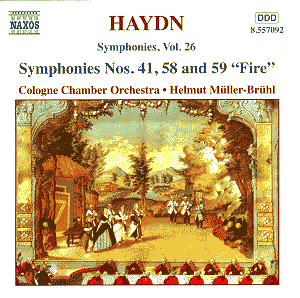It is interesting that for many musicians the
course of their professional career has been to evolve away from
the use of the modern everyday instruments that they were brought
up on. The aspiration is to playing period instruments. Where
this happens it is either through the good fortune of a guiding
hand - a teacher or conductor - or through personal diligence.
The Cologne Chamber Orchestra who have been most
ably guided by Helmut Müller-Bruhl for, astonishingly, almost
forty years, have developed in reverse. To quote the booklet notes,
"From 1976 to 1987 the ensemble played on period instruments
under the name Capella Clementina. With this baroque formation
Müller-Bruhl … set a standard for historical performance
practice and the revival of baroque music theatre. Since 1987
the orchestra, now the Cologne Chamber Orchestra, has played according
to the principles of historic performance practice (but) on modern
instruments, and so can meet the demands of modern concert halls".
Does this imply that original instruments have
insufficient weight or do not carry in modern day concert halls?
Does it imply that the ensemble is not taken seriously playing
old instruments? Does it imply that record companies found them
harder to package and sell? I leave it to you to decide. Anyway
these are historically aware performances and most convincing
they are too. These are three fascinating symphonies in which
I again find myself gripped by Haydn’s originality and ability
to surprise.
I will not compare them with other performances
because at Naxos’s budget price these new recordings are incomparable.
Not only that but these three symphonies have not been coupled
together before. I will therefore confine myself to a brief discussion
of the music for the reader to decide if they are worth searching
out.
The numbering of Haydn’s symphonies has always
been something of a puzzle. These works date from 1769 (No. 41
and No.59) and 1768 (No.58). Middle period Haydn sometimes demonstrates
‘sturm und drang’. The ‘Fire’ Symphony with its Presto first movement
is a good example. In these compositions, more than those of his
contemporaries, he evolved a ‘modern’, mobile, driving style of
writing. The sonata form with its dramatic ‘development’ and with
fluent and free polyphony enlivens the inner parts. Sometimes,
as in the first and third movements of the Symphony No.58 the
‘style galant’, with its emphasis on melody not polyphony, takes
centre-stage. The first movement is marked Allegro but I had to
check the CD cover and track to work out if I was imagining it
as it is played here as a slightly accelerated Minuet. Haydn up
to his old tricks again or is it just played too slowly? A real
Minuet, arguably a second one, takes up its customary place as
the third movement. This however is marked ‘alla zoppa’ which,
according to Keith Anderson, in his helpful notes, means ‘lame’;
a title "justified by the irregular rhythms of the melody".
Incidentally the rondo finale of this symphony reminds this reviewer
of C.P.E Bach with quirky, surprising unisons, dramatic dips into
the minor, unexpected silences and a sudden ending. Great fun.
I know of some reviewers who have been annoyed
at the prominent use of harpsichord continuo in Haydn symphonies
as here. Looking back on some great Haydn conductors it’s interesting
that Franz Bruggen who is acutely aware of style and period in
his Philips recordings of the mid-1990s does not use harpsichord.
If you say that it is because he mainly tackled the later symphonies
then I could also mention that Harnoncourt, recording in the early
1990s for Das Alte Werk in works like the 30th Symphony
(1765), takes a similar stance. Whereas for Sigiswald Kuijken
on Virgin (late 1980s) the harpsichord is there but is not a strong
presence. Müller-Bruhl seems to take the view that Haydn
may well have directed from the harpsichord (although he was primarily
a violinist) and its presence is a strong factor. Does it matter?
Probably not except that the prominent harpsichord gives the works
a stronger sense of chamber music, which might appeal to you.
Yet to hear the harpsichord tinkling away at the same triplet
rhythms as the brass (for example in the presto finale of the
C major symphony) reminds me of a famous Beecham quote that I
hadn’t better repeat here.
The playing is always crisp and incisive with
some especially felicitous woodwind playing and clear brass work
in, for example, the first movement of the C major Symphony.
Gary Higginson
see also review
by John portwood

